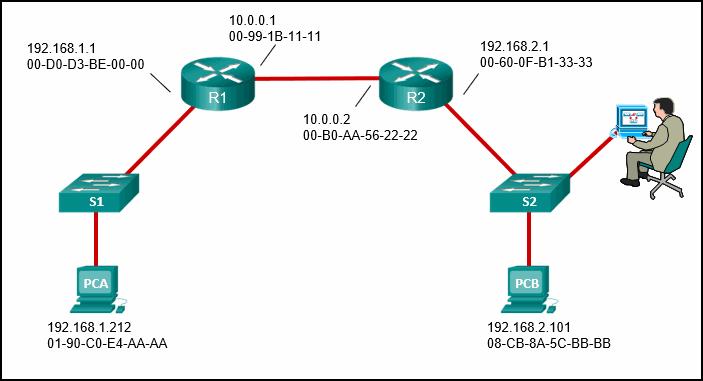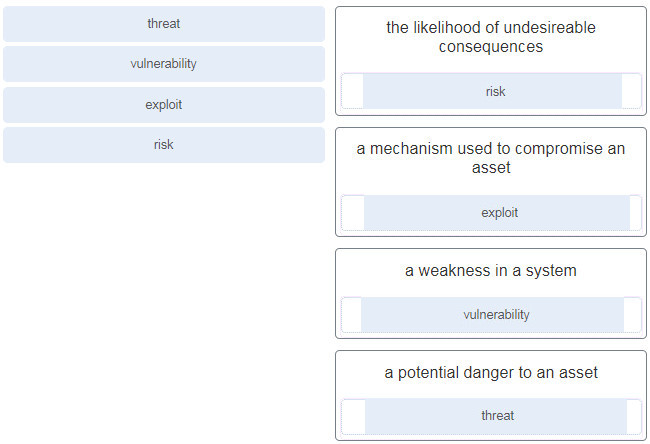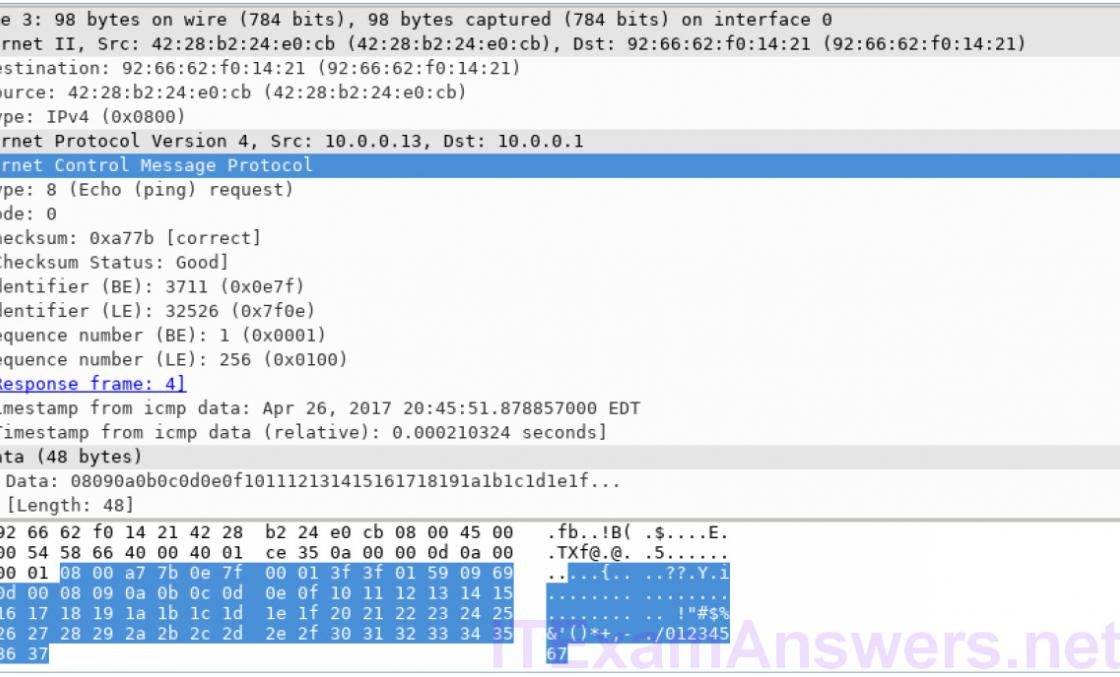- Which network service synchronizes the time across all devices on the network?
- NetFlow
- Syslog
- NTP *
- SNMP
- Which network service allows administrators to monitor and manage network devices?
- NTP
- SNMP *
- Syslog
- NetFlow
- What are two types of addresses found on network end devices? (Choose two.)
- UDP
- return
- IP
- TCP
- MAC
- Which OSI layer header is rewritten with new addressing information by a router when forwarding between LAN segments?
- Layer 2
- Layer 3
- Layer 4
- Layer 7
- Which wireless parameter is used by an access point to broadcast frames that include the SSID?
- passive mode
- security mode
- channel setting
- active mode
- A Cisco router is running IOS 15. What are the two routing table entry types that will be added when a network administrator brings an interface up and assigns an IP address to the interface? (Choose two.)
- route that is learned via OSPF
- route that is learned via EIGRP
- route that is manually entered by a network administrator
- directly connected interface
- local route interface
- Refer to the exhibit. The network “A” contains multiple corporate servers that are accessed by hosts from the Internet for information about the corporation. What term is used to describe the network marked as “A”?
- perimeter security boundary
- internal network
- DMZ
- untrusted network
- Which protocol provides authentication, integrity, and confidentiality services and is a type of VPN?
- MD5
- AES
- ESP
- IPsec
- Which wireless parameter refers to the frequency bands used to transmit data to a wireless access point?
- SSID
- Security mode
- Scanning mode
- Channel settings *
- What specialized network device uses signatures to detect patterns in network traffic?
- Bridges
- Switches
- IDS *
- Firewalls
- What type of physical topology can be created by connecting all Ethernet cables to a central device?
- Star *
- Bus
- Ring
- Mesh
- What are two uses of an access control list? (Choose two.)
- ACLs can control which areas a host can access on a network.
- ACLs provide a basic level of security for network access.
- Standard ACLs can restrict access to specific applications and ports.
- ACLs can permit or deny traffic based upon the MAC address originating on the router.
- ACLs assist the router in determining the best path to a destination.
- Which protocol or service is used to automatically synchronize the software clocks on Cisco routers?
- SNMP
- NTP
- DHCP
- DNS
- What is the only attribute used by standard access control lists to identify traffic?
- source MAC address
- protocol type
- source IP address
- source TCP port
- What is the role of an IPS?
- to detect patterns of malicious traffic by the use of signature files
- to filter traffic based on defined rules and connection context
- to filter traffic based on Layer 7 information
- to enforce access control policies based on packet content
- Which two features are included by both TACACS+ and RADIUS protocols? (Choose two.)
- SIP support
- password encryption
- 802.1X support
- separate authentication and authorization processes
- utilization of transport layer protocols
- What does the TACACS+ protocol provide in a AAA deployment?
- AAA connectivity via UDP
- compatibility with previous TACACS protocols
- authorization on a per-user or per-group basis
- password encryption without encrypting the packet
- Which parameter is commonly used to identify a wireless network name when a home wireless AP is being configured?
- ESS
- SSID
- ad hoc
- BESS
- What information within a data packet does a router use to make forwarding decisions?
- the destination service requested
- the destination IP address
- the destination host name
- the destination MAC address
- Which protocol creates a virtual point-to-point connection to tunnel unencrypted traffic between Cisco routers from a variety of protocols?
- GRE
- IPsec
- OSPF
- IKE
- Which two statements are true about NTP servers in an enterprise network? (Choose two.)
- NTP servers at stratum 1 are directly connected to an authoritative time source.
- NTP servers ensure an accurate time stamp on logging and debugging information.
- There can only be one NTP server on an enterprise network.
- All NTP servers synchronize directly to a stratum 1 time source.
- NTP servers control the mean time between failures (MTBF) for key network devices.
- What is true concerning physical and logical topologies?
- Physical topologies display the IP addressing scheme of each network.
- Logical topologies refer to how a network transfers data between devices.
- The logical topology is always the same as the physical topology.
- Physical topologies are concerned with how a network transfers frames.
- Which layer of the hierarchical design model is a control boundary between the other layers?
- access
- network
- distribution
- core
- Which protocol or service allows network administrators to receive system messages that are provided by network devices?
- NTP
- NetFlow
- SNMP
- syslog
- What is a function of a proxy firewall?
- uses signatures to detect patterns in network traffic
- connects to remote servers on behalf of clients
- drops or forwards traffic based on packet header information
- filters IP traffic between bridged interfaces
- What is the function of the distribution layer of the three-layer network design model?
- aggregating access layer connections
- providing high speed connection to the network edge
- providing secure access to the Internet
- providing direct access to the network
- Which LAN topology requires a central intermediate device to connect end devices?
- star
- ring
- bus
- mesh
- Which device can control and manage a large number of corporate APs?
- switch
- WLC
- router
- LWAP
- For which discovery mode will an AP generate the most traffic on a WLAN?
- active mode
- mixed mode
- passive mode
- open mode
- What is a feature of the TACACS+ protocol?
- It utilizes UDP to provide more efficient packet transfer.
- It hides passwords during transmission using PAP and sends the rest of the packet in plaintext.
- It encrypts the entire body of the packet for more secure communications.
- It combines authentication and authorization as one process.
Subscribe
Login
0 Comments
Oldest





